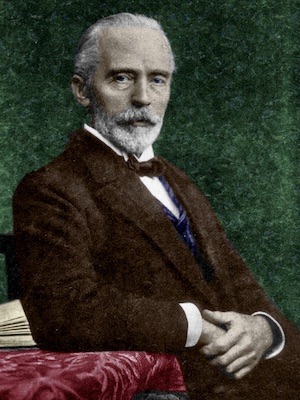Emil Theodor Kocher
Emil Theodor Kocher (1841 – 1917) was a Swiss Surgeon.
The Nobel Prize in Physiology or Medicine 1909 was awarded to Theodor Kocher “for his work on the physiology, pathology and surgery of the thyroid gland“. Performed over 5,000 thyroid excisions with a reduction in mortality from 14% in 1884 to 0.18% in 1898
Along with Lister and Hallsted, Kocher introduced aseptic technique to surgical operations greatly reducing mortality rates.
Biography
- Born August 25, 1841, Bern, Switzerland
- 1860-1865 – Medical studies Universität Bern
- 1909 – Nobel Prize in Physiology or Medicine for work on then thyroid gland
- 1909 – Theodor Kocher Institute (TKI) in Bern was established
- 1911 – Retired
- Died July 27, 1917, Bern, Switzerland
The surgeon is a doctor who can operate and knows when he should not do it.
Medical Eponyms
Signs/Syndromes
- Kocher sign – in patients with Basedow-Graves disease
- Kocher Reflection (Kocher’s reflex): contraction of the abdominal muscles subsequent to the exploratory compression of the testicle.
- Kocher-Debré-Semélaigne syndrome: syndrome of hypothyroidism associated muscular enlargement to give the appearance of an infant Hercules.
Operative procedures
- Kocher arc incision: oblique incision for opening the knee joint
- Kocher incision: subcostal incision performed on the right side exposes the gallbladder and common bile duct, and on the left side gives access to splenectomy or splenorenal venous anastomosis.
- Kocher’s incision II: Tranverse incision over the thyroid for glandular removal
- Kocher manoeuvre (Kocherization) – Operative mobilization of the duodenum to expose the retroduodenal, intrapancreatic and intraduodenal portions of the common bile duct before performing other procedures locally or before incising the duodenum
- Kocher’s method: fixation of the uterus to the abdominal wall.
- Kocher’s method II: Method for reducing dislocations of the shoulder (rotation method). The head of the joint is rotated in place with a sudden change between inward and outward rotation, while the arm is simultaneously raised. [Eine neue Reductionsmethode für Schulterverrenkung]
- Kocher Operation – relates to a few operations…
- Method of excision of the ankle joint
- Method to reduce the subcoracoid dislocation of the humerus (1870)
- Procedure of removal of the tongue
- Procedure of pilorectomy
Equipment
- Kocher craniometer
- Kocher tweezers: Arterial tweezers with hooks at the end
- Kocher Surgical Clamp – used to prevent blood loss during surgery (1882)
- Kocher zonde
Key Medical Attributions:
Thyroid Surgery: Extensive work on the thyroid gland. Based on his 1883 work on the thyroid gland’s function in metabolism and demonstration that thyroid surgery should be ‘hygienic’; associated with minimal blood loss and that a viable part of the gland needs to be left intact following the operation.
Aseptic Surgery: Recognized the importance of aseptic techniques and introduced aseptic techniques of Lister whilst evolving his own. Careful evaluation of post-operative wound complication led him to ban visitors form the operating theatre…
Neurosurgery: research was pioneering and covered the areas of concussion, neurosurgery and intracranial pressure (ICP) found that decompressive craniectomy was an effective method to lower ICP. Worked with Harvey Cushing in 1900 first encountering the Cushing reflex during decompressive surgery
Surgical instruments: A craniometer; surgical clamp; arterial tweezers and forceps
Research Statistics: (“arithmetical observations”) were introduced to prove the beneficial effect of “radical surgical techniques” and to control their quality. Death rates, incidence of infections, follow-ups etc were assessed and reported. Kocher recorded all operations in notebooks and later published e.g. 119 inguinal hernia operations (1892); 1513 appendectomies (1913) and 2712 with goitres treated with iodine injections (1873)
Major Publications
- Kocher T. Eine neue Reductionsmethode für Schulterverrenkung. Berliner Klinische Wochenschrift 1870; 7(9): 101-105. [Kocher’s method]
- Kocher T. Zur Pathologie und Therapie des Kropfes. Deutsche Zeitschrift für Chirurgie, Leipzig, 1874, 4: 417-440. [Kocher sign]
- Kocher T. Die antiseptische Wundbehandlung [Antiseptic wound treatment] 1881
- Kocher T. Die Krankheiten der männlichen Geschlechtsorgane. 1887
- Kocher T. Chirurgische Operationslehre [Operative surgery] Jena, Fischer, 1892.
- Kocher T. Zur Verhütung des Cretinismus und cretinoider Zustände nach neueren Forschungen. Deutsche Zeitschrift für Chirurgie, 1892; 34(1): 556-626. [Kocher-Debré-Semélaigne syndrome]
- Kocher T. Vorlesungen über chirurgische Infektionskrankheiten [Lectures on surgical infectious diseases] 1895
- Kocher T. Beiträge zur Kenntniss einiger praktisch wichtiger Fracturformen. 1896
References
- Theodor Kocher – Facts. Nobelprize.org. Nobel Media AB 2014
- Bibliography. Emil Theodor Kocher. WorldCat Identities
- Aguirre CP. Biography: Emil Theodor Kocher (1841-1917). University of Valencia – CSIC 2002.
- Choong C, Kaye AH. Emil theodor kocher (1841-1917). J Clin Neurosci. 2009; 16(12): 1552-4.
- Schültke E. Theodor Kocher’s craniometer. Neurosurgery. 2009; 64(5): 1001-4
- Gemsenjäger E. Theodor Kocher (1841-1917). Milestones in European Thyroidology (MET)
- Tröhler U. Der Nobelpreisträger Theodor Kocher 1841-1917. Birkhäuser publisher Basel 1984

